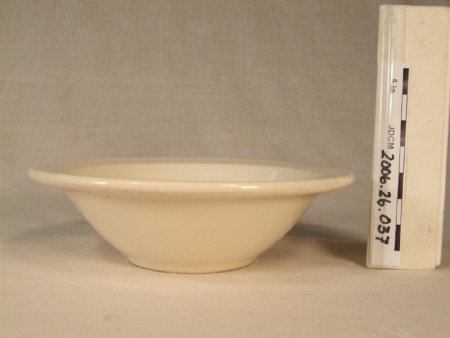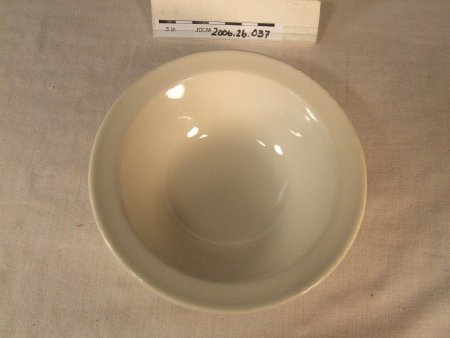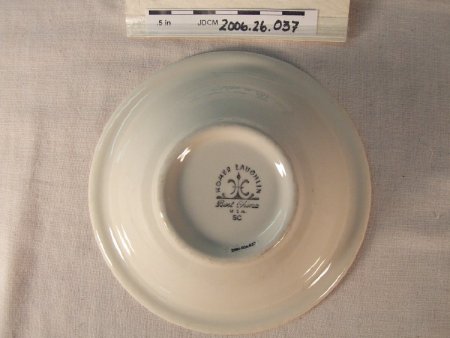Collection:
Juneau—Douglas City Museum
Object ID:
2006.26.037
Accession#:
2006.26
Credit Line:
Donated by LInda Wahto.
Object Name:
Bowl
Title:
White Ceramic Bowl "Homer Laughlin USA SC"
Description:
White Ceramic Bowl. "Homer Laughlin Best China USA SC" printed on bottom.
http://www.hlchina.com/history.htm
The Homer Laughlin China Company owes its origin to a two—kiln pottery on the banks of the Ohio River in East Liverpool, Ohio. Built in 1871 by Homer Laughlin and his brother Shakespeare, the Laughlin Pottery was one of the first whiteware plants in the country.
In 1897, Mr. Laughlin sold his interest to William Edwin Wells and Louis I. Aaron. Since then, successive generations of the two families have continued to manage the company. With the success of the company came rapid growth. Three new plants replaced the original facility. In 1907, the headquarters and a new thirty—kiln plant were built across the Ohio River in Newell, West Virginia, the present manufacturing and headquarters location. At this time the company operated sixty—two production kilns and forty—eight decorating kilns, providing a capacity of thirty thousand pieces of finished pottery per day—— a full ten per cent of the dishes purchased in the United States.
The turning point in the artistic focus of the company came in 1927 with the addition of noted ceramist Frederick Hurton Rhead. His design vision would culminate in the 1936 introduction of Fiesta®, Homer Laughlin's best selling line, and today one of the most collected china products in the world.
Until 1959, Homer Laughlin made only semi—vitrified earthenware products for the consumer markets. With the introduction of a new, fully vitrified china line, the company was now able to participate in the restaurant/hotel markets.
The hotel/restaurant introduction was such a success that Homer Laughlin concentrated its efforts on the food service market and continued to add new shapes, patterns and decorating techniques throughout the 1960's and 1970's. The reintroduction of Fiesta® in 1986 as a high—fire, fully vitrified, lead—free product redefined the standard for both food service and retail china products.
II. The Homer Laughlin China Company Today and Tomorrow
The Homer Laughlin China Company has been a leader in the design and manufacture of food service and retail china products for over one hundred twenty years. A heritage rich in American tradition and innovation has given Homer Laughlin China the fortitude to look to the next century with anticipation of meeting even greater challenges.
As a leader the china design and manufacturing market, Homer Laughlin has pursued the issues that affect the market: lead—free product, glaze abrasion, contemporary design and timely delivery.
Important beyond all factors of kilns, machinery and computers are the skills of the ancient craft and the integrity of the potter. The Homer Laughlin China Company, as it has for well over a century, stands committed to the production of ware of high quality, artistic merit and enduring value.
http://www.hlchina.com/history.htm
The Homer Laughlin China Company owes its origin to a two—kiln pottery on the banks of the Ohio River in East Liverpool, Ohio. Built in 1871 by Homer Laughlin and his brother Shakespeare, the Laughlin Pottery was one of the first whiteware plants in the country.
In 1897, Mr. Laughlin sold his interest to William Edwin Wells and Louis I. Aaron. Since then, successive generations of the two families have continued to manage the company. With the success of the company came rapid growth. Three new plants replaced the original facility. In 1907, the headquarters and a new thirty—kiln plant were built across the Ohio River in Newell, West Virginia, the present manufacturing and headquarters location. At this time the company operated sixty—two production kilns and forty—eight decorating kilns, providing a capacity of thirty thousand pieces of finished pottery per day—— a full ten per cent of the dishes purchased in the United States.
The turning point in the artistic focus of the company came in 1927 with the addition of noted ceramist Frederick Hurton Rhead. His design vision would culminate in the 1936 introduction of Fiesta®, Homer Laughlin's best selling line, and today one of the most collected china products in the world.
Until 1959, Homer Laughlin made only semi—vitrified earthenware products for the consumer markets. With the introduction of a new, fully vitrified china line, the company was now able to participate in the restaurant/hotel markets.
The hotel/restaurant introduction was such a success that Homer Laughlin concentrated its efforts on the food service market and continued to add new shapes, patterns and decorating techniques throughout the 1960's and 1970's. The reintroduction of Fiesta® in 1986 as a high—fire, fully vitrified, lead—free product redefined the standard for both food service and retail china products.
II. The Homer Laughlin China Company Today and Tomorrow
The Homer Laughlin China Company has been a leader in the design and manufacture of food service and retail china products for over one hundred twenty years. A heritage rich in American tradition and innovation has given Homer Laughlin China the fortitude to look to the next century with anticipation of meeting even greater challenges.
As a leader the china design and manufacturing market, Homer Laughlin has pursued the issues that affect the market: lead—free product, glaze abrasion, contemporary design and timely delivery.
Important beyond all factors of kilns, machinery and computers are the skills of the ancient craft and the integrity of the potter. The Homer Laughlin China Company, as it has for well over a century, stands committed to the production of ware of high quality, artistic merit and enduring value.
Notes:
Collection donated by Linda Wahto, brought in by donor's daughter Myiia Whistler. According to Whistler, Wahto and Willette Janes would hunt bottles together. Bottles found in Treadwell/Douglas area. Some are from Myiia's grandfather's house/cabin on the Treadwell Ditch. He grew up there — they tossed garbage into the ditch. Mom/Grandma and Janes would bottle hunt up at the cabin site.
People:
Wahto, Linda
Janes, Willette
Whistler, Myiia
Janes, Willette
Whistler, Myiia
Search Terms:
Household
Restaurant
Food
Restaurant
Food


